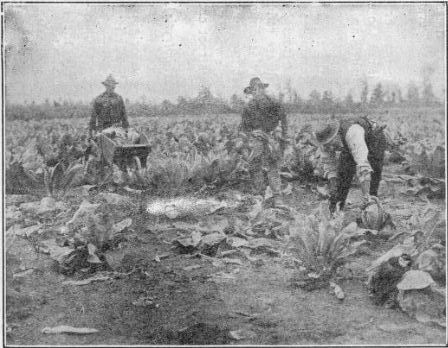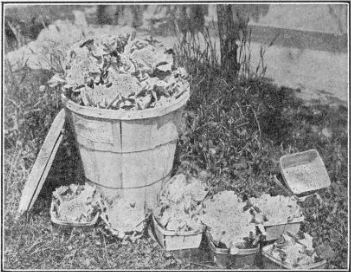Cauliflower (Brassica Oleracea, Var. Botrytis)
Description
This section is from the book "Vegetable Gardening", by Ralph L. Watts. Also available from Amazon: Vegetable Gardening.
Cauliflower (Brassica Oleracea, Var. Botrytis)
380. History
Cauliflower is of European origin and has probably been developed from broccoli. It is generally regarded as the most refined and the most delicate member of the cabbage family. When properly prepared for the table, it is unquestionably the most delicious representative of this group of vegetables. The heads, which are simply the shortened and thickened parts of the flowers, may be cooked and pickled or prepared for the table as cabbage or Brussels sprouts. Cauliflower was probably first grown in this country for commercial purposes on Long Island.
381. Importance
For many years cauliflower has been a very important field and garden crop on Long Island. There are immense areas at the east end of the island and many small but highly intensive ones near Brooklyn at the west end. Its cultivation has been extended to most of the states, but the crop is especially important in California, Florida, the Great Lake district and in other sections providing suitable climatic conditions.

Fig. 74. LONG ISLAND FIELD OF CAULIFLOWER. COLLECTING FOR MARKET.
Except in the most favored sections, it is a difficult crop to grow. Many uncertainties attend its production. The young plants are very susceptible to damping-off fungi. A hard frost may stunt the growth of the young plants, causing the heads to "bolt" or "button"; that is, the heads may break or send up their flowering parts before they, have attained a marketable size. Poor seed or dry weather at the time of heading may cause the same trouble. Because of the uncertainty thousands of growers do not attempt cauliflower culture. Although the supply is liberal at times in some of our large markets, most cities are only fairly well supplied, and there is usually a good demand for large, white heads.
382. Climate
Proper climatic conditions are universally regarded as more important than a congenial soil. This vegetable has become accustomed to a cool, moist climate; it rebels against heat, dry weather and low humidity. Regions near large bodies of water, as on Long Island, along the Atlantic Coast, in the Great Lake district and at Puget Sound, furnish ideal conditions. Some inland sections, however, have produced fairly good results. Growers in Garrett County, Md., have had splendid success. They are located about 3,000 feet above sea level, where the air is cool, and where there are fogs or a moist atmosphere most of the time. High temperatures, low humidity and lack of soil moisture tend to check growth, and therefore, reduce the size of the heads, which are thus probably caused to "button." Overhead irrigation is especially valuable for this crop.
The plants are much less hardy than cabbage. This fact must be taken into account when planting in the spring and also when harvesting in the fall. Although they stand some frost, severe freezing should be guarded against at all times. Figure 74 shows a Long Island field of cauliflower.
383. Soil
A constant and liberal supply of moisture is the most important factor in a soil; good drainage, however, is also essential. The rich, heavy loams provide excellent conditions, although splendid crops are often produced in light soils. Low, well-drained bottom land, even if sandy, produces good results if climatic conditions are satisfactory.
384. Varieties
Three varieties of early cauliflower are grown extensively. Dwarf Erfurt is one of the best known; Snowball is popular in many sections; and Snowstorm is valued, especially for forcing.
Seafoam and Dry Weather are important late varieties, regarded particularly valuable for inland sections. Algiers and Autumn Giant are also planted for the late crop.
385. Seed
Most of the cauliflower seed used in the United States is grown in Denmark. For seed production, still more favorable conditions must prevail than for the development of heads. Certain sections of Denmark, particularly in the vicinity of Copenhagen, furnish these requirements. While the bulk of our seed is imported, the Puget Sound region has been growing some high-grade seed. A great deal of inferior seed is offered to the trade. The best seed ranges in price from $3 to $7 an ounce. This amount should be sufficient to start 2,500 to 3,000 plants.
386. Raising Early Plants
Early cauliflower plants are started in the same way as early cabbage, but greater care must be exercised. The soil should be sterilized and made only moderately rich. There should be a constant supply of moisture in the beds or flats, but overwatering must be carefully guarded against. Free ventilation is important. The aim should be to produce a moderate, healthy, unchecked growth from seed sowing until the plants are established in the open ground.
As cauliflower plants are more tender than cabbage plants, it is customary to sow somewhat later, March 1 probably being early enough for the coldest sections of the North. The plants will then be ready for the field early in May, after the danger of hard frosts. Many growers prefer to transplant when the seedlings are very small, not more than an inch high. Planting them 2x2 inches apart does not give too much space, but provides free circulation of air around the plants, which may be removed from beds or flats with plenty of soil or compost, so that growth will not be materially checked. An excellent plan is to transplant into flower pots, which are then plunged in sand or ashes to prevent drying out.
387. Raising Late Plants
Methods relating to the growing of late cabbage plants (350) apply equally well to late cauliflower, except that more care must be taken. As the seed is much more expensive, it should be sown more sparingly, so that each seed will produce a good plant. Some gardeners prefer to transplant once before setting where the crop is to mature. When this is not done the transfer should be made before the plants are too large and when both soil and atmospheric conditions are favorable.
388. Fertilizing
The cauliflower requires even greater fertility than cabbage. Rotten manure should be used in large amountsó50 tons an acre, if obtainable at reasonable prices. A ton or more of high-grade fertilizer to the acre can also be used to advantage. Lime is regarded as valuable and is used extensively as a preventive of club root.
389. Planting
The early plants should not be planted in the open until after danger of hard frosts. The late plants may be set from the latter part of June until August I, as the locality and the condition of the soil may permit. The general practice is to plant early enough so that the heads will form before the hot midsummer weather, and to start the late plants so they will begin heading with the lower temperatures of the early fall months. Although the crop may be and is matured at midseason, the task is regarded as difficult, because heading does not progress so satisfactorily in hot, dry weather. The planting distances are the same as for early and late cabbage.
390. Cultivation
Clean tillage is required to prevent weed growth and to conserve moisture. In the small, intensive plantations, wheel hoes are used extensively; in field culture, the spike-toothed cultivators are most popular.
391. Protecting The Heads
The market pays the highest prices for pure white heads, but these cannot be produced without protection from rain and sunshine. This is accomplished by fastening the leaves over the heads in such a manner as to shed rain and to prevent the sun's rays from reaching the delicate heads. The operation should be attended to when the heads are small. Sometimes several leaves are brought together and tied. Some growers prefer to break or bend a number of outside leaves over the heads. This plan is not very thorough. Toothpicks are effective in fastening the leaves.
392. Marketing
As cauliflower is one of the most delicate and easily damaged vegetables, it should be handled with the greatest care. It is often packed in barrels, which are far from being ideal packages for such a perishable product. Crates are better and are gaining in popularity. They usually hold about two dozen heads, but the one-dozen crate provides still better carrying conditions. Basket hampers are used sometimes. (See Figure 75.) The product should go to market in the most dainty condition; paraffin paper wrapped about each head will help to accomplish this purpose. Such a plan is particularly desirable when prices are high.
393. Returns
Returns are extremely variable, ranging from $100 to $1,000 or even more an acre, $400 an acre being a highly satisfactory return.
394. Insects And Diseases
The same as of cabbage. See paragraphs 363, 364, 365, 366, 367 and 368.

Fig. 75. cauliflower packed for market.
Continue to:
- prev: 375. Planting Carrot
- Table of Contents
- next: Celeriac Or Turnip-Rooted Celery (Apium Graveolens, Var. Rapaceum)
Tags
plants, crops, gardening, cultivated, harvesting, food ,greenhouses, fertiliser, vegitables
